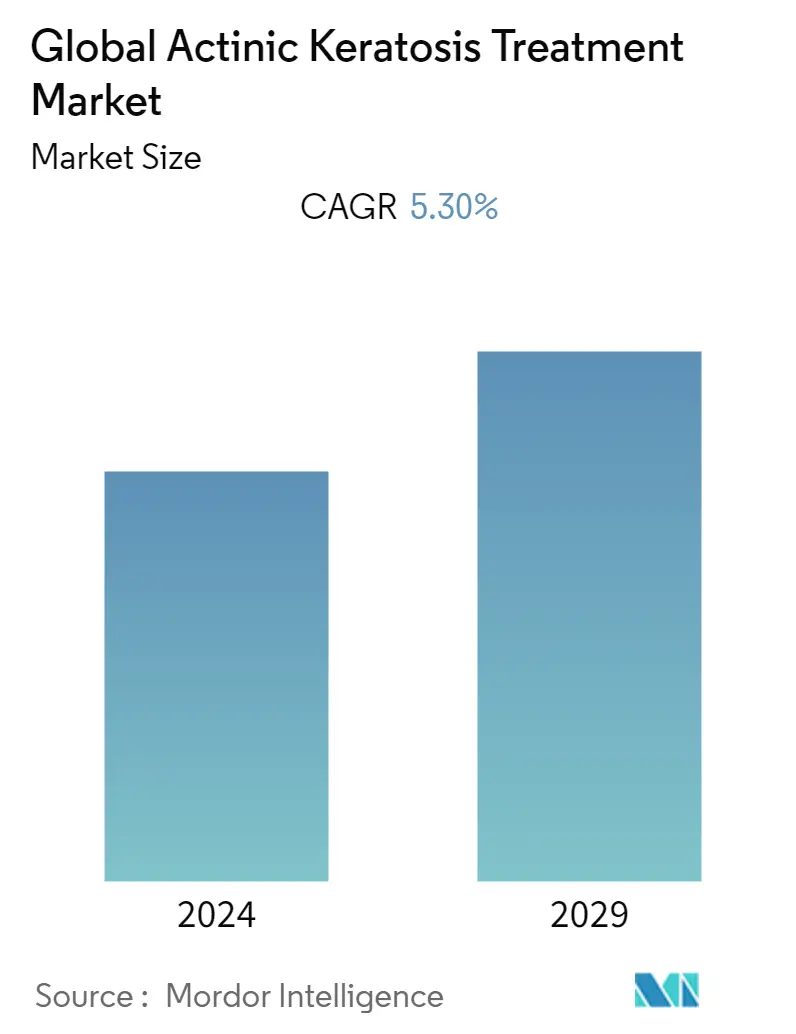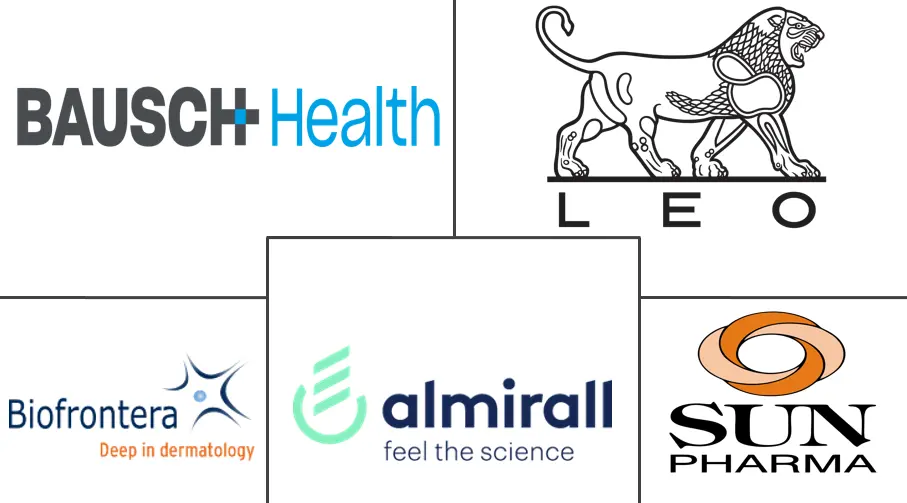Market Size of Global Actinic Keratosis Treatment Industry

| Study Period | 2019 - 2029 |
| Base Year For Estimation | 2023 |
| CAGR | 5.30 % |
| Fastest Growing Market | Asia Pacific |
| Largest Market | North America |
| Market Concentration | Medium |
Major Players
*Disclaimer: Major Players sorted in no particular order |
Actinic Keratosis Treatment Market Analysis
The actinic keratosis treatment market is expected to register a CAGR of 5.3% during the forecast period.
The COVID-19 pandemic had a significant impact on the actinic keratosis treatment market. There was a decrease in the number of aesthetic procedures performed worldwide during the COVID-19 pandemic to reduce the risk of viral transmission. For instance, according to an article published by Elsevier Public Health Emergency Collection, in February 2021, during the crisis, dermatologists were involved in managing cutaneous manifestations related to COVID-19 and occupational disease caused by personal protective equipment. The reduction in the number of procedures was attributed to the fear and risk of infection from COVID-19. However, with the adoption of telemedicine and teleconsultations during the pandemic, the demand for dermatological treatment increased, which led to a rise in the demand for actinic keratosis treatment. However, as COVID-19 cases have declined and the pandemic accelerated the use of teledermatology, the studied market is expected to project stable growth over the studied period.
The increasing prevalence of actinic keratosis, growing demand for minimally invasive procedures, and increasing research and development for developing novel therapies are the key driving factors in the market. For instance, according to an article published by the Indian Journal of Dermatology, in April 2022, actinic keratosis is one of the most frequently seen signs in the outpatient setting and was diagnosed at more than 10% of dermatology visits. In the UK, 15%-23% of individuals have actinic keratosis lesions, and this reaches 37.5% among people older than 50 years of age. This is likely to increase the adoption of the available treatment and early diagnosis of the disease. Furthermore, according to an article published by MDPI, in June 2022, photodynamic therapy (PDT) using 5-aminolevulinic acid (5-ALA) is an emerging treatment option in the care of actinic keratosis. This increase in the prevalence of actinic keratosis leading to a surge in minimally invasive procedures such as photodynamic therapy is expected to aid the overall market growth in the studied period.
The recent product launches by the key market players are also aiding the market growth. For instance, in November 2022, Biofrontera Inc. launched a randomized, double-blind, vehicle-controlled, multicenter Phase 3 clinical study to evaluate the safety and efficacy of Ameluz and BF-RhodoLED XL in the field-directed treatment of actinic keratosis (AK) on the extremities, neck, and trunk. Furthermore, in September 2021, Almirall, S.A. launched Klisyri (tirbanibulin) in Germany and the U.K. The product was launched upon approval from the U.K.'s Medicines & Healthcare Products Regulatory Agency (MHRA) and the European Commission for treating actinic keratosis of the scalp and face in adults.
Risk factors associated with available treatment options may restrain the market growth over the forecast period.
Actinic Keratosis Treatment Industry Segmentation
As per the scope of the report, actinic keratosis is a rough, scaly patch on skin that develops from years of exposure to solar radiation. It is commonly found on the face, lips, ears, back of hands, forearms, scalp, or neck.
The Actinic Keratosis Treatment Market is Segmented By Therapy Type (Topical Medications (Fluorouracil, Imiquimod, Ingenol Mebutate, and Other Medications), and Procedures (Photodynamic Therapy, Laser, and Other Procedures)), End User (Hospitals and Oncology Centers, Dermatology Clinics, and Other End Users), and Geography (North America, Europe, Asia-Pacific, Middle East and Africa, and South America). The market report also covers the estimated market sizes and trends for 17 different countries across major regions globally. The report offers the market size and forecasts in value (USD million) for the above segments.
| By Therapy | ||||||
| ||||||
|
| By End User | |
| Hospitals and Oncology Centers | |
| Dermatology Clinics | |
| Other End Users |
| Geography | ||||||||
| ||||||||
| ||||||||
| ||||||||
| ||||||||
|
Global Actinic Keratosis Treatment Market Size Summary
The actinic keratosis treatment market is poised for steady growth, driven by the increasing prevalence of the condition and a rising demand for minimally invasive procedures. The market experienced a temporary setback during the COVID-19 pandemic due to a decrease in aesthetic procedures and concerns over viral transmission. However, the adoption of telemedicine and teleconsultations helped mitigate this impact, leading to a resurgence in demand for dermatological treatments, including actinic keratosis. Key factors propelling market growth include the development of novel therapies and the introduction of innovative treatment options such as photodynamic therapy, which is gaining traction due to its noninvasive nature and effectiveness. Recent product launches and clinical studies by major players further bolster market expansion, despite potential challenges posed by risk factors associated with available treatments.
North America is expected to maintain a significant share of the global actinic keratosis treatment market, attributed to the high prevalence of the condition and a substantial aging population. The region's market growth is supported by ongoing initiatives, product launches, and strategic agreements among key industry players. The market is moderately concentrated, with several global and regional companies actively participating in the development and distribution of treatment options. The presence of these companies, along with regulatory approvals and partnerships, is anticipated to drive market dynamics. As the incidence of actinic keratosis continues to rise, particularly in regions closer to the equator, the demand for effective treatment solutions is expected to increase, supporting the overall growth trajectory of the market.
Global Actinic Keratosis Treatment Market Size - Table of Contents
-
1. MARKET DYNAMICS
-
1.1 Market Overview
-
1.2 Market Drivers
-
1.2.1 Increasing Prevalence of Actinic Keratosis Worldwide
-
1.2.2 Growing Demand for Minimally Invasive Procedures
-
1.2.3 Favorable Reimbursement Policies
-
-
1.3 Market Restraints
-
1.3.1 Risk Factors Associated With Available Treatment Options
-
-
1.4 Porter's Five Forces Analysis
-
1.4.1 Threat of New Entrants
-
1.4.2 Bargaining Power of Buyers/Consumers
-
1.4.3 Bargaining Power of Suppliers
-
1.4.4 Threat of Substitute Products
-
1.4.5 Intensity of Competitive Rivalry
-
-
-
2. MARKET SEGMENTATION (Market Size by Value - USD million)
-
2.1 By Therapy
-
2.1.1 Topical Medications
-
2.1.1.1 Fluorouracil
-
2.1.1.2 Imiquimod
-
2.1.1.3 Ingenol Mebutate
-
2.1.1.4 Other Medications
-
-
2.1.2 Procedures
-
2.1.2.1 Photodynamic Therapy
-
2.1.2.2 Laser
-
2.1.2.3 Other Procedures
-
-
-
2.2 By End User
-
2.2.1 Hospitals and Oncology Centers
-
2.2.2 Dermatology Clinics
-
2.2.3 Other End Users
-
-
2.3 Geography
-
2.3.1 North America
-
2.3.1.1 United States
-
2.3.1.2 Canada
-
2.3.1.3 Mexico
-
-
2.3.2 Europe
-
2.3.2.1 Germany
-
2.3.2.2 United Kingdom
-
2.3.2.3 France
-
2.3.2.4 Italy
-
2.3.2.5 Spain
-
2.3.2.6 Rest of Europe
-
-
2.3.3 Asia-Pacific
-
2.3.3.1 China
-
2.3.3.2 Japan
-
2.3.3.3 India
-
2.3.3.4 Australia
-
2.3.3.5 South Korea
-
2.3.3.6 Rest of Asia-Pacific
-
-
2.3.4 Middle East and Africa
-
2.3.4.1 GCC
-
2.3.4.2 South Africa
-
2.3.4.3 Rest of Middle East and Africa
-
-
2.3.5 South America
-
2.3.5.1 Brazil
-
2.3.5.2 Argentina
-
2.3.5.3 Rest of South America
-
-
-
Global Actinic Keratosis Treatment Market Size FAQs
What is the current Global Actinic Keratosis Treatment Market size?
The Global Actinic Keratosis Treatment Market is projected to register a CAGR of 5.30% during the forecast period (2024-2029)
Who are the key players in Global Actinic Keratosis Treatment Market?
Sun Pharmaceutical Industries Limited, Biofrontera AG, Bausch Health Companies Inc., LEO Pharma A/S and Almirall, S.A. are the major companies operating in the Global Actinic Keratosis Treatment Market.

